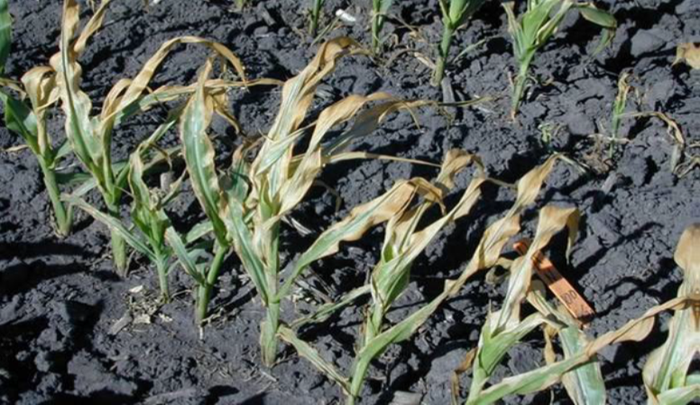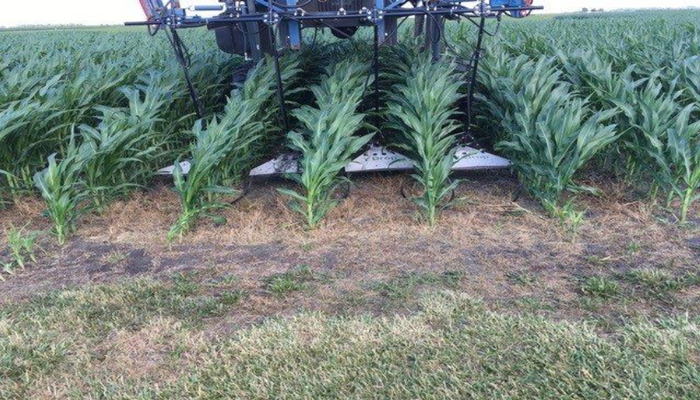May 6, 2022

Importance of Nitrogen in Corn
Nitrogen is an essential nutrient for corn growth and maximization of yield potential. Plants with N deficiency can be easily identified by a characteristic yellowing on younger plants, and an inverted “V” shaped yellowish discoloration starting from the tip of the leaf up to the midrib in mature plants.
Nitrogen shortages can appear quickly in seedling corn, if N was not applied prior to planting or due to environmental conditions such as cold and wet or extremely dry can prevent N uptake. Corn plants require an adequate amount of N starting at the V5 (5 collared leaves) through V8 growth stage because the number of potential ears and ear girth is determined during this growth period. The quickest N uptake occurs from about the V8 growth stage through silking providing environmental conditions are favorable for plant growth.

Impact of Nitrogen in Corn
The yield potential for corn plants not fertilized with N can be greatly reduced as plant-available N in the soil becomes depleted. Research conducted in Iowa demonstrated an average yield of 60 bu/acre for continuous corn and 115 bu/acre for corn following soybean when additional N is not applied.2

Within the plant, N is critical for photosynthesis and production of amino acids, proteins, and chlorophyll. Without chlorophyll (which gives the plants their green color), photosynthetic processes and potential yield are compromised and reduced, respectively. Applying all N preplant has the risk of being lost to the environment through leaching or denitrification. Lost N is not only unavailable for crop growth but becomes an environmental concern when it enters waterways and the air. Sidedress and pre-tassel N applications can help reduce environmental concerns associated with N loss, supply N closer to maximum crop uptake, and allow for adjusting N rates depending on current growth, plant population, and environmental forecasts.
The majority of N should be applied just before rapid vegetative growth begins. For split side-dressing applications of N, Mississippi State University recommends applying no more than 1/3 of the total N at crop emergence and then applying the remaining N amount about 30 days later when corn is at or beyond the V6 growth stage.2 UAN liquids are applied to the leaves.
Sources of Nitrogen
Urea-ammonium nitrate (UAN) and anhydrous ammonia are good N fertilizers to use when sidedressing corn.
Urea-Ammonium Nitrate. Early-season sidedressing can be accomplished with an applicator that injects N (Figure 2, page 1) or can be surfaced applied in the form of urea or 28% or 32% UAN liquid solutions. Surface applied N should receive rainfall or irrigation, or be tilled in soon after application to avoid volatilization which can be up to 30% within two weeks if temperatures are warm. Urea granules can burn the leaves when they fall into the plant whorls or when UAN liquids are applied to the leaves.

To help reduce the risk of burning leaves, UAN recommendations include:
Applying less than 90 lbs UAN/acre when corn is at growth stages V3 or V4.
Applying less than 60 lbs UAN/acre at V7 growth stage.
Drops should be used after V7 through pre-tassel nitrogen (PTN) to apply a concentrated UAN band application at an N rate that supports current yield potential.
Anhydrous Ammonia. In general, the injection of anhydrous ammonia is potentially the best sidedressing choice. Best management practices (BMP) for applying anhydrous ammonia as a sidedress include:
Applications should be to the moist, not wet soil.
Applications should occur prior to root expansion into the row middles to avoid root damage.
Applications can begin immediately after planting.
The injection can be between every row or every other row.
To avoid snapping off plants, applications should occur before plants are too tall for the toolbar.
Applicator safety precautions should be followed to avoid injury to eyes and limbs.
Pre-tassel N (PTN) application
Another time period for a growing season N application is when the plants enter the V10 growth stage and just prior to tasseling (VT). An application during this period is referred to as PTN. Recommended PTN application rates range from 15-25% of the total N to be applied. The other 85-75% of total applied N should have already been split between a preplant injection or a side-dress operation. Equipment such as a 360 Y-Drop® applicator should be considered for a PTN application to place N near the plant base and to reduce the potential for plant breakage.

Should weather conditions prevent a side-dress application, a PTN application can help supply needed N. University trials have demonstrated that a late PTN application can improve yield potential.3
Source: DeKalb AsGrow, which is solely responsible for the information provided and is wholly owned by the source. Informa Business Media and all its subsidiaries are not responsible for any of the content contained in this information asset.
You May Also Like




